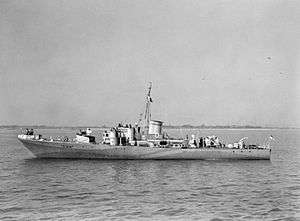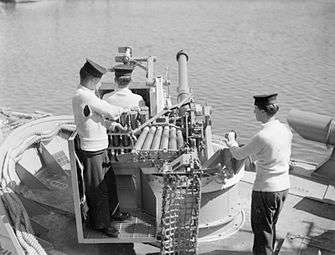Coastal Forces of the Royal Navy

Coastal Forces was a division of the Royal Navy established during World War II under the command of Rear Admiral Coastal Forces.[1]
History




Predecessor
The Royal Navy had previously operated flotillas of small torpedo- and depth-charge-armed craft (Coastal Motor Boats) during World War I (1914-1918). They operated as often in action against the enemy coast as in defence of British coastal areas.
Establishment
During World War II (1939-1945), the first Coastal Forces headquarters was set up at HMS Vernon in 1940 under Rear Admiral Piers Kekewich, Flag Officer Coastal Forces. The Chief Staff Officer to the Rear Admiral was Augustus Agar, VC, who had commanded coastal motor boats during World War I and in British operations in the Baltic Sea in 1918 and 1919 in support of White Russian forces during the Russian Civil War.
World War II operations
Royal Navy Coastal Forces craft operated mainly in the English Channel and North Sea waters, especially in the build up to the Normandy invasion of 1944. They were also used in the Mediterranean[2] and off Norwegian coastline.[3]" They raided St. Nazaire and Dieppe. They were used to attack German convoys and their S-boat (known to the Allies as "E-Boat") escorts, carry out clandestine raids and landings, and pick up secret agents in Norway and Brittany. The coastal craft were manned by various Allied nationalities including Dutch, Norwegian, Canadian, Australian, and New Zealanders."[4]
A number of Captain-class frigates were configured to operate as "Coastal Forces Control Frigates" (CFCF).[5] Operating with Coastal Forces officers embarked and responsible for controlling and providing radar support to groups of Coastal Forces motor torpedo boats intercepting German motor torpedo boats in the North Sea,[6] these frigates were involved in the destruction of at least 26 E-Boats.[7]
By 1944 Coastal Forces numbered 3,000 officers and 22,000 ratings. Altogether there were 2,000 British Coastal Forces craft. Affectionately known as the Royal Navy's "Little Ships", they fought over 900 actions and sank around 400 enemy vessels, including 48 E-boats and 32 midget submarines. They fired 1,169 torpedoes, shot down 32 enemy aircraft and carried out many mine laying operations. 170 of the "Little Ships" were sunk or otherwise destroyed.[8]
Post-World War II
After World War II, the Royal Navy redesignated all its motor torpedo boats (MTBs) and motor gun boats (MGBs) as "fast patrol boats." The Brave-class fast patrol boats were the last craft to be built for the Coastal Forces, and the Coastal Forces were disbanded as a separate unit and their last base, (HMS Hornet), decommissioned in 1956.
The last sailors to wear the "HM Coastal Forces" cap tally were the ship's companies of the inshore minesweepers HMS Dittisham (M2621) and HMS Flintham (M2628) on being taken out of reserve in 1968, before individual cap tallies for the minesweepers had been manufactured and issued.
Craft types used
Coastal Forces included the following types of coastal defence craft:[9]
| Type[10] | Designation | Built | Lost | Designed purpose |
|---|---|---|---|---|
| Motor Launches | ML, HDML, RML | Harbour defence and submarine chasing or rescue motor launches. | ||
| Motor Gun Boats | MGB | |||
| Steam Gun Boats | SGB | 7 | 1 | Hunting down German E-boats |
| Motor Torpedo Boats | MTB |
At the outbreak of World War II in September 1939 there were three flotillas of Motor Torpedo "short boats" between 60 ft (18 m) and 72 feet (22 m) long. These could typically maintain 40 knots and were armed with two torpedo tubes. They were built mainly by the British Power Boat Company, Vospers, and Thornycroft.
In 1940 a modified craft, the Motor Gun Boat, was introduced. These were armed with weapons such as the 0.5 in Vickers machine gun, 2 pounder "pom pom", a single or twin 20 mm Oerlikon and ultimately the autoloader fitted 6-pounder gun.[11]
It was also apparent that larger craft were needed as the operational capability of the short boats was too restricted by sea conditions. Fairmile designed a series of larger coastal craft, up to 120 feet (37 m) long. The Fairmile A Type and B Type were motor launches and the C Type was a motor gun boat.[12]
In 1943 the Fairmile D Type appeared. It was a motor torpedo boat – nicknamed the "Dog Boat" – and was designed as a counter to the German S-boat (known to the Allies as the "E-boat"). It could be fitted as either a gun or a torpedo boat, so the designation "MGB" disappeared and all the craft were labelled MTBs. It was a good sea boat and could maintain 30 knots (56 km/h) at full load. The later D types carried four 18-inch (460 mm) torpedo tubes.[13]
The Vosper Type I MTB appeared in 1943. This was a 73-foot (22 m) craft with four 18-inch (460 mm) torpedo tubes and was capable of a maximum speed of 40 knots (74 km/h).
Bases
Coastal Forces bases were located around the British coast and at major locations overseas.[14][15][16][17]
|
|
Commonwealth coastal forces
Although British Commonwealth coastal forces operated independently from British ones, they used similar vessels:
| Coastal forces of | Type | Built | Lost | Notes |
|---|---|---|---|---|
| Canada | Fairmile B motor launch Fairmile D motor torpedo boat BPB Motor Torpedo Boat |
80[20] 10[21] 11[22] |
||
| Australia | Harbour Defence Motor Launch Fairmile B motor launch |
31[23] 35[24] |
||
| New Zealand | Harbour Defence Motor Launch Fairmile B motor launch |
16[25] 12[26] |
Surviving craft
| Vessel | Description | Built | Builder | In the care of | Condition |
|---|---|---|---|---|---|
| HDML 1387 Medusa | Harbour defence launch which took part in the Normandy landings.[27] | 1943 | R.A.Newman & sons | Medusa Trust[28] | restored to original condition |
| MTB102 | Prototype for World War II MTBs[29] | 1937 | Vosper | MTB102 Trust[30] | still seaworthy |
| MTB 331 | 55 ft (17 m) Stepped-hull motor torpedo boat - sole survivor[31] | 1941 | Thornycroft | British Military Powerboat Trust[32] | Intention to get her seaworthy |
| MGB 81 | 71.5 ft (21.8 m) Motor gun boat | 1942 | British Power Boat Company | British Military Powerboat Trust[33] | Fully operational |
| MTB 71 | 60 ft (18 m) Motor torpedo boat | 1940 | Vosper | Static exhibit |
Some surviving motor launches in British waters were taken on as pleasure boats and a number of them are on the National Register of Historic Vessels.
See also

- Royal Naval Patrol Service
- Trawlers of the Royal Navy
- Coastal Forces of World War II
- Coastal Forces of the Royal Canadian Navy
- Coastal Forces of the Royal Australian Navy
- Coastal Forces of the Royal New Zealand Navy
- Robert Peverell Hichens RNVR MTB Flotilla leader
References
Notes
- ↑ Royal Navy Coastal Forces
- ↑ Reynolds, L.C. and Cooper, H.F. (1999) Mediterranean MTBs at War: Short MTB Flotilla Operations, 1939-45
- ↑ for example Operation Brandy or MTB 345
- ↑ Coastal Forces of World War Two (Royal Naval Museum)
- ↑ Donald. The Captain Class Frigates in the Second World War. p. 31.
- ↑ Donald. The Captain Class Frigates in the Second World War. pp. 124, 139.
- ↑ The Coastal Forces Heritage Trust: Coastal Forces Achievements
- ↑ The Coastal Forces Heritage Trust: Our Objectives
- ↑ Note that minesweepers, trawlers and landing craft are not included.
- ↑ Allied Coastal Forces of World War II - Volume II: Vosper designs and US Elcos - by John Lambert and Al Ross, 1993 ISBN 0-85177-602-7
- ↑ Allied Coastal Forces of World War II - Volume I: Fairmile designs and US Submarine Chasers - by John Lambert and Al Ross, 1990 ISBN 978-0-85177-519-7
- ↑ The Fairmile D Motor Torpedo Boat (Anatomy of the Ship's series) by John Lambert, 1985 ISBN 0-85177-321-4
- ↑ Coastal Forces Shore establishments
- ↑ Combined Operations Training Establishments
- ↑ List of Royal Navy shore establishments
- ↑ Western Approaches Command Bases
- ↑
- ↑ "Things to Do – Dartmouth Museum". Dartmouth Museum. Retrieved 23 August 2011.
The Royal Dart Hotel between the ferries played a vital role in the Second World War. It was called HMS Cicala then.
- ↑ Canadian Fairmile Bs
- ↑ Canadian Fairmile Ds
- ↑ BPB Motor Torpedo Boat
- ↑ Australian HDMLs
- ↑ Australian Fairmile Bs
- ↑ New Zealand HDMLs
- ↑ New ZealandFairmile Bs
- ↑ HDML 1387 Medusa
- ↑ Medusa Medusa Trust
- ↑ MTB102
- ↑ MTB102 Trust
- ↑ MTB-331 - 55 ft (17 m) coastal motor torpedo boat Archived March 15, 2008, at the Wayback Machine.
- ↑ British Military Powerboat Trust MTB 331
- ↑ British Military Powerboat Trust MGB 81
Bibliography
- Cooper, Bryan. (1972) Battle of the Torpedo Boats. ISBN 978-0-330-23243-2
- Holman, Gordon (1944) The Little Ship. London: Hodder & Stroughton OCLC 2300084
- Konstam, Angus (2003) British Motor Torpedo Boat 1939–45. Osprey ISBN 1-84176-500-7
- Lambert, John and Ross, Al (1990) Allied Coastal Forces of World War II, Volume I: Fairmile designs and US Submarine Chasers. ISBN 978-0-85177-519-7
- Lavery, Brian (2006) Churchill's Navy: The Ships, Men and Organisation, 1939-1945, ISBN 978-1-84486-035-7
- Kemp, Paul J (1997) British Coastal Forces of WW2, ISO Publications, London, ISBN 0-946784-52-3
- Konstam, Angus and Bryan, Tony. British Motor Torpedo Boat 1939-45. ISBN 978-1-84176-500-6
- Pickles, Harold (1995) Untold Stories of Small Boats at War: Coastal Forces Veterans Remember ISBN 978-1-85821-176-3
- Pope, Dudley (2006) Flag 4: The Battle of Coastal Forces in the Mediterranean 1939-1945. ISBN 978-1-86176-067-8
- Reynolds, L.C. and Cooper, H.F. (1999) Mediterranean MTBs at War: Short MTB Flotilla Operations, 1939-45. ISBN 978-0-7509-2274-6
- Reynolds, L. C. (2000) Home Waters MTBs at War: Channel and North Sea MTB and MGB Flotilla Operations, 1939-1945. ISBN 978-0-7509-2518-1
- Reynolds, L. C. and Lord Lewin (2000) Dog Boats at War: A History of the Operations of the Royal Navy D Class Fairmile Motor Torpedo Boats and Motor Gunboats 1939-1945, Sutton Publications Inc, ISBN 978-0-7509-2454-2
- Reynolds, L. C. (2002) Motor Gunboat 658: The Small Boat War in the Mediterranean. ISBN 978-0-304-36183-0
- Scott, Peter and Hichens, Antony (2009) The Battle of the Narrow Seas: A History of the Light Coastal Forces in the Channel and North Sea, 1939-1945 (reprint) Naval Institute Press. ISBN 9781591140412.
- Royal Naval Museum - Reading list
- Coastal Forces Heritage Trust - Books About Coastal Forces
- Imperial War Museum (27 June 2001). "Imperial War Museum Department of Printed Books Recommended Reading List (No. 348): Coastal Forces – Second World War" (PDF). Retrieved 4 April 2013.
External links
- Royal Navy Coastal Forces Veterans
- Coastal, inshore and special naval warfare
- The Coastal Forces Heritage Trust
- British Military Powerboat Trust: Boat Histories
- Coastal Forces, Clandestine Naval Ops and Landing Craft
- Coastal Forces
- UK National Register of Historic Vessels
- Royal Navy Coastal Forces training base, mainly for MLs
- Royal Navy Coastal Warfare Vessels Lost at Sea
- Motor Launches and MTBs of the Coastal Forces
- Personal recollections